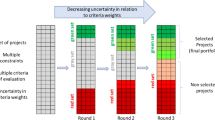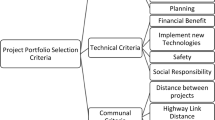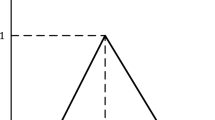Abstract
International conglomerates often take financial risks by investing funds in potential projects without conducting comprehensive assessments of the uncertainties associated with economic and political factors, which contribute to overall international business risks. In this study, an analytic hierarchy process (AHP) based approach has been developed as a practical decision-making tool for project selection in project management. The AHP enables the identification of the most valuable projects among various potential options, ensuring that investors benefit from the proposed advantages outlined in the project business plans. The capital expenditure (CAPEX), operating expenditure (OPEX), environment, social and governance (ESG) and ease of business (EOB) are the criteria selected and organised into a hierarchical framework of the AHP. The projects under each criterion are prioritised by assigning overall weights through pairwise matrix comparisons. To ensure the reliability and consistency of the pairwise comparisons, the eigenvector method is employed to evaluate the consistency of the economic freedom sub-criterion under EOB. Similarly, the AHP is applied to the CAPEX, OPEX and ESG criteria using consistent scoring and rating systems for pairwise comparisons, which enables the determination of their overall weights. Based on the analysis, the relative weightage of each decision criterion has been identified, and the score of each project has been estimated. LNG import and re-gasification terminal in Southwest India is chosen as the project with the greatest potential to fulfil the diverse requirements of the companies. Capital cost contributes the most to this decision because the projects considered in this case are highly capital intensive. At the same time, the overall scores of four projects are comparable, and thus, the final decision selection may also be based on the specific priorities of the investors.




Similar content being viewed by others
Data Availability
Not available.
Code Availability
Not available.
References
Alcalá P (2021) Is austerity creating safety concerns for PEMEX?. Mexico Business News. Retrieved from: https://mexicobusiness.news/oilandgas/news/austerity-creating-safety-concerns-pemex
Alcántara-Ayala I (2009) Disasters in Mexico and Central America. A little bit more than a century of natural hazards. Dev Earth Surface Process 13(C):75–97. https://doi.org/10.1016/S0928-2025(08)10004-9
Alonso JA, Lamata MT (2006) Consistency in the analytic hierarchy process: A new approach. International Journal of Uncertainty, Fuzziness and Knowlege-Based Systems 14(4):445–459. https://doi.org/10.1142/S0218488506004114
Aydin U (2019) Energy insecurity and renewable energy sources: Prospects and challenges for Azerbaijan. In: ADBI working paper 992. Asian Development Bank Institute, Tokyo. Retrieved from: https://www.adb.org/publications/energy-insecurity-renewable-energysources-challenges-azerbaijan
Basak M, Perrons RK, Coffey V (2019) Schedule overruns as a barrier for liquefied natural gas projects: a review of the literature and research agenda. Energy Rep 5:210–220. https://doi.org/10.1016/j.egyr.2019.01.008
Bertelsen K, Sedlacek M (2014) Energy sector overview. Retrieved from: https://s3.wp.wsu.edu/uploads/sites/606/2015/02/SectorOverview_ENE_Spring2014.pdf
Boruff B et al (2003) Tornado hazards in the United States. Clim Res 24:103–117. https://doi.org/10.3354/cr024103
CFI (2021) Energy sector - overview, components, and factors. Retrieved from: https://corporatefinanceinstitute.com/resources/careers/jobs/energy-sector/. Accessed 11 Dec 2021
Coleman N (2021) Kashagan operator battles sea level drop with new dredging project. S&P Global. Retrieved from: https://www.spglobal.com/commodityinsights/pt/market-insights/latest-news/oil/040921-kazakhstans-kashagan-oiloperator-battles-sea-level-drop-with-new-dredging-project
Cordes EE, Jones Daniel OB, Schlacher Thomas A, Amon Diva J, Bernardino Angelo F, Sandra B, Robert C, DeLeo Danielle M, Dunlop Katherine M, Escobar-Briones Elva G, Gates Andrew R, Luciana G, Judith G, Lea-Anne H, Santiago H, Sarah H, Mandy J, Salit K, Mestre Nélia C et al (2016) Environmental impacts of the deep-water oil and gas industry: a review to guide management strategies. Front Environ Sci 4. https://doi.org/10.3389/fenvs.2016.00058
Czech K, Niftiyev I (2021) The impact of oil price shocks on oil-dependent countries’ currencies: The case of Azerbaijan and Kazakhstan. J Risk Financ Management 14:431. https://doi.org/10.3390/jrfm14090431
Delamaide E, Moreno WP (2015) Enhanced oil recovery of heavy oil in reservoirs with bottom aquifer. In: Paper presented at the SPE western regional meeting, Garden Grove. https://doi.org/10.2118/174050-MS
Diggs A (2012) The expiration of the ethanol tax credit: an analysis of costs and benefits. Policy Perspect 19(Phaaneuf 2007):47. https://doi.org/10.4079/pp.v19i0.10425
EcoSys (2018) Project selection: A guide to project prioritization and selection | EcoSys. Retrieved from: https://www.ecosys.net/blog/project-selection-prioritization-guide/. Accessed 11 Dec 2021
Hanaki K, Portugal-Pereira J (2018) The effect of biofuel production on greenhouse gas emission reductions. In: Takeuchi K, Shiroyama H, Saito O, Matsuura M. (eds) Biofuels and sustainability. Science for Sustainable Societies. Springer, Tokyo. https://doi.org/10.1007/978-4-431-54895-9_6
International Trade Adminstration (2021) Mexico - country commercial guide. Retrieved from: https://www.trade.gov/country-commercial-guides/mexico-oil-and-gas. Accessed 23 Nov 2021
Iwaszczuk N, Wolak J, Iwaszczuk A (2021) Turkmenistan’s gas sector development scenarios based on econometric and swot analysis. Energies 14(10):1–18. https://doi.org/10.3390/en14102740
Jayakumar K, Panda RC, Panday A (2017) ‘A review: state-of-the-art LPG sweetening process. Int J Greenhouse Gas Control 9(2):175–206
Jurík L, Horňáková N, Šantavá E et al (2022) Application of AHP method for project selection in the context of sustainable development. Wireless Netw 28:893–902. https://doi.org/10.1007/s11276-020-02322-2
Kar SK, Vaid M (2016) India advancing LNG projects to bridge gas-supply gap. Oil Gas J 114:76–76
Kluhto S (2013) Mathematical decision making an overview of the analytic hierarchy process. Retrieved from: https://www.whitman.edu/Documents/Academics/Mathematics/Kluhto.pdf.
Lamprou A, Vagiona D (2018) Success criteria and critical success factors in project success: a literature review. Int J Real Estate Land Plan 1:2623–4807
Lopes F (2021) How natural gas could thwart or support India’s renewables progress. Business Standard. Retrieved from: https://www.business-standard.com/article/current-affairs/how-natural-gas-could-thwart-or-supportindia-s-renewables-progress-121101900140_1.html
Media (2020) Mexico’s new refinery quest draws criminal attention. Retrieved from: https://www.argusmedia.com/en/news/2128426-mexicos-new-refinery-quest-draws-criminal-attention
Mokhatab S, Mak JY, Valappil JV, Wood DA (2014) LNG fundamentals in handbook of liquefied natural gas. Gulf Professional Publishing, pp 1–106. https://doi.org/10.1016/B978-0-12-404585-9.00001-5
Molavi-Arabshahi M, Arpe K, Leroy SAG (2016) Precipitation and temperature of the southwest Caspian Sea region during the last 55 years: their trends and teleconnections with large-scale atmospheric phenomena. Int J Climatol 36(5):2156–2172. https://doi.org/10.1002/joc.4483
Nguyen GH (2014) The analytic hierarchy process: a mathematical model for decision making problems. Senior Independent Study Theses [Preprint]
Ooi J, Ng DKS, Chemmangattuvalappil NG (2018) Optimal molecular design towards an environmental friendly solvent recovery process. Comput Chem Eng 117:391–409. https://doi.org/10.1016/j.compchemeng.2018.06.008
Oxford Business Group (2019) Mexico’s plans to upgrade existing new oil refineries and build a new facility. Retrieved from: https://oxfordbusinessgroup.com/analysis/capacity-boost-government-plansupgradecountry’s-six-refineries-and-construct-new-facility
Palcic I, Lalic B (2009) Analytical hierarchy process as a tool for selecting and evaluating projects. Int J Simul Model 8:16–26. https://doi.org/10.2507/IJSIMM08(1)2.112
Parvaneh F, El-Sayegh SM (2016) Project selection using the combined approach of AHP and LP. J Financ Manag Prop Constr 21(1):39–53. https://doi.org/10.1108/JFMPC-09-2015-0034
Petroleum and Natural Gas Regulatory Board (2019) Petroleum and natural gas regulatory board notifications, New Delhi. Retrieved from: https://www.pngrb.gov.in/OurRegulation/pdf/Gazette-Regulation/English/GSR808(E)-E.pdf
Petrović AM (2021) Challenges of reliable power supply with an emphasis on renewables. In: Leal Filho W, Marisa Azul A, Brandli L, Lange Salvia A, Wall T (eds) Affordable and clean energy. Encyclopedia of the UN sustainable development goals. Springer, Cham. https://doi.org/10.1007/978-3-319-95864-4_95
Pinedale (2016) Hazards of natural gas. Retrieved from: https://www.pinedalegas.com/index.php?option=com_content&view=article&id=76&Itemid=493
Pospíšil J et al (2018) (2019) Energy demand of liquefaction and regasification of natural gas and the potential of LNG for operative thermal energy storage. Renew Sustain Energ Rev 99:1–15. https://doi.org/10.1016/j.rser.2018.09.027
Rakheja H (2021) What is green hydrogen? Can India make it affordable? Retrieved from: https://www.business-standard.com/podcast/current-affairs/what-is-green-hydrogen-can-india-makeitaffordable-121112500012_1.html
Rass S et al (2020) Mathematical decision making. Advanced Sciences and Technologies for Security Applications 43–78. https://doi.org/10.1007/978-3-030-46908-5_3
Renshaw J, Kelly S (2021) Exclusive: U.S. oil industry seeks unusual alliance with Farm Belt to fight Biden electric vehicle agenda. Reuters. Retrieved from: https://www.reuters.com/article/us-usa-biden-electriccars-exclusive-idUSKBN29X2O8
Saaty RW (1987) The analytic hierarchy process-what it is and how it is used. Math Model 9(3–5):161–176. https://doi.org/10.1016/0270-0255(87)90473-8
Saaty TL (2008) Decision making with the analytic hierarchy process. Int J Services Sciences 1(1):83–98
Shiva Kumar S, Himabindu V (2019) Hydrogen production by PEM water electrolysis – a review. Mater Sci Energ Technol 2(3):442–454. https://doi.org/10.1016/j.mset.2019.03.002
Singh G, Sharma D, Jain C (2021) Impact of inflation and GDP Of India and the United States on its current foreign exchange currency market rate. Int J Sci Res Publ (IJSRP) 11(2):474–485. https://doi.org/10.29322/ijsrp.11.02.2021.p11057
Snell W (2021) U.S. and global food price inflation, economic and policy update. Retrieved from: https://agecon.ca.uky.edu/files/u.s._and_global_food_price_inflation.pdf.
Spetzler C, Winter H, Meyer J (2016) The requirements for decision quality. In Decision quality value creation from better business decisions. John Wiley & Sons, Ltd, pp 11–20. https://doi.org/10.1002/9781119176657
Strong CB (2018) The oil and gas law review. Retrieved from: https://thelawreviews.co.uk/title/theoil-and-gas-law-review
Tan RR, Aviso KB, Huelgas AP, Promentilla MAB (2014) Fuzzy AHP approach to selection problems in process engineering involving quantitative and qualitative aspects. Process Saf Environ Prot 92:467–475. https://doi.org/10.1016/j.psep.2013.11.005
Tan J, Low KY, Sulaiman NMN, Tan RR, Promentilla MAB (2016) Fuzzy analytic hierarchy process (FAHP) for multi-criteria selection of microalgae harvesting and drying processes. Clean Technol Environ Policy 18:2049–2063. https://doi.org/10.1007/s10098-016-1163-6
Ten JY, Liew ZH, Oh XY et al (2021) Computer-aided molecular design of optimal sustainable solvent for liquid-liquid extraction. Process Integr Optim Sustain 5:269–284. https://doi.org/10.1007/s41660-021-00166-7
Tenenbaum DJ (2008) Food vs. fuel: diversion of crops could cause more hunger. Environ Health Perspect 116(6):A254–A257. https://doi.org/10.1289/ehp.116-a254
The Global Economy (2020) Political stability by country. Available at: https://www.theglobaleconomy.com/rankings/wb_political_stability/. Accessed 19 Nov 2021
The Associated Press (2021) At least 17 killed. dozens missing as heavy rains hit southern India. NBC News. Retrieved from: https://www.nbcnews.com/news/world/least-17-killeddozensmissing-heavy-rains-hit-southern-india-rcna6233
The World Bank (2006) Implementation completion and results report guidelines. Republic of Azerbaijan, Operations Policy and Country Services (OPCS). Retrieved from: http://wwwwds.worldbank.org/external/default/WDSContentServer/WDSP/IB/2012/12/24/000386194_20121224050237/Rendered/PDF/NonAsciiFileName0.pdf
The World Bank (2011) Analysis of disaster risk management in Columbia: A contribution to the creation of public policies. Retrieved from: https://openknowledge.worldbank.org/handle/10986/12308
Triantaphyllou E, Mann SH (1995) Using the analytic hierarchy process for decision making in engineering applications: some challenges. Int J Ind EngTheory Appl Pract 2(1):35–44
Wainberg M (2009) Hydrocarbon production update : Colombia, Brazil, Mexico and Venezuela. International Association for Energy Economics, pp 21–25
Zaretskaya (2020) Growth in India’s LNG imports will depend on completion of connecting pipelines. U.S, Energy Information Administration. Retrieved from: https://www.eia.gov/todayinenergy/detail.php?id=43655
Zavala-Araiza D et al (2021) A tale of two regions: Methane emissions from oil and gas production in offshore/onshore Mexico. Environ Res Lett 16(2). https://doi.org/10.1088/1748-9326/abceeb
Author information
Authors and Affiliations
Corresponding author
Ethics declarations
Competing Interests
The authors declare no competing interests.
Additional information
Publisher's Note
Springer Nature remains neutral with regard to jurisdictional claims in published maps and institutional affiliations.
Appendices
Appendix
Table 15.
Application of Analytic Hierarchy Process
The outcomes of AHP for different aspects, namely OPEX, ESG and ease of business are shown here.
-
OPEX
For OPEX pairwise comparison, estimation of cost for each project was based on the existing plants in the country. In order to ensure reliable comparison, the estimated cost was divided by the production capacity provided. The operating cost estimated is illustrated in Table 16. With these values, they are used as the basis for pairwise comparison for low OPEX.
Referring to Table 17, it can be observed that project 4 has the highest weightage, followed by project 1, project 3, project 2, project 6 and project 5. The reason that project 5 scores the lowest is because of its high OPEX in operating the electrolyser for the production of green hydrogen. On the other hand, project 6 is having high OPEX compared to projects 1, 2, 3 and 4 since it is a refinery industry, which is expected to have higher operating costs. The estimation of cost for project 6 is taken from the annual report from the existing refinery company in Mexico, Pemex.
-
ESG
For environmental, social and governance (ESG), several aspects were considered, namely the political, social stability, economic freedom and environmental performance index (EPI) ranking, as shown in Table 18. Based on Table 19, project 2 scores the highest since the USA has better ranking in economic freedom and EPI ranking compared to the remaining countries. The weightage for projects 1, 3, 5 and 6 are considered comparable as they are quite close to each other.
-
Ease of Business
In terms of ease of business, it is ranked based on the global ranking of the countries, which is collected from The Global Economy (2020), as can be seen in Table 20. It was believed that the higher the global ranking, the easier it was to start a business in the country. Table 21 is the summarised version of the pairwise comparison for ease of business.
Rights and permissions
Springer Nature or its licensor (e.g. a society or other partner) holds exclusive rights to this article under a publishing agreement with the author(s) or other rightsholder(s); author self-archiving of the accepted manuscript version of this article is solely governed by the terms of such publishing agreement and applicable law.
About this article
Cite this article
Lee, H.Y., Heng, Y.P., Selvanathan, K. et al. Multi-Criteria Decision-Making Tools for Project Selection by International Conglomerates. Process Integr Optim Sustain 8, 375–393 (2024). https://doi.org/10.1007/s41660-023-00376-1
Received:
Revised:
Accepted:
Published:
Issue Date:
DOI: https://doi.org/10.1007/s41660-023-00376-1




